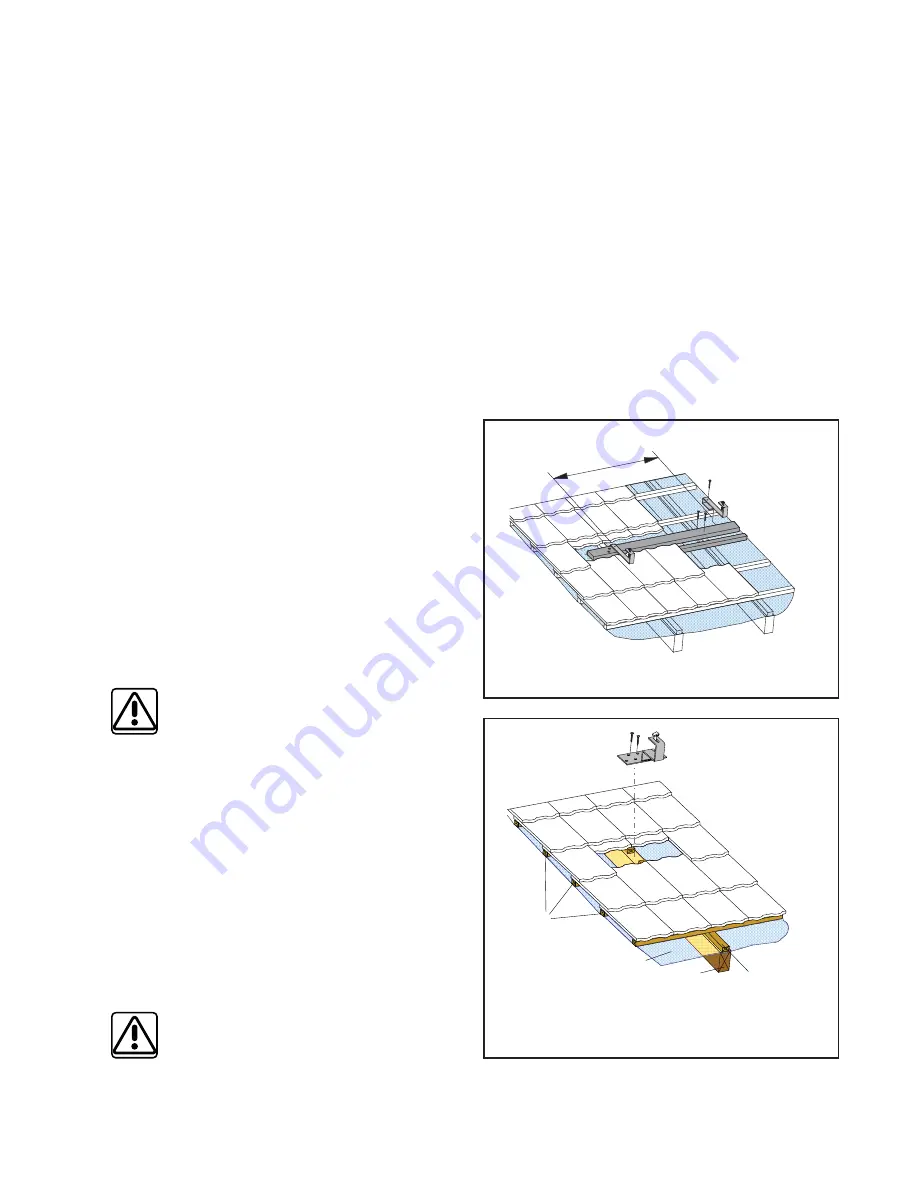
8
board. For this anchor type also the rail
fi
tting height can
be adjusted.
Installation
• Remove roo
fi
ng in places where anchors shall be
fi
tted
(Fig. 5). The distance “a” between anchors is de
fi
ned
in Fig. 2.
• Cut the counter batten used for fastening the waterpro-
o
fi
ng membrane.
• Prior to the installation itself, use an underlay for
anchors according to the thickness of battens and
counter battens so that the anchors installed do not
hinder proper positioning of the roof tiles.
• Screw the adjustable aluminum anchor to a rafter and
move it in the groove horizontally so that it doesn’t
hinder proper positioning of the roof tile. If a
fi
xed
stainless steel anchor is used, its position shall be
adjusted before faastening.
• Fit all the other roof anchors in the same way.
• When installing roof anchors, maintain a direction
parallel to the roo
fi
ng (horizontal).
2.1.3 Installation with roof anchors for shin-
gle or metal roofs
• Depending on the number of collectors, measure and
calculate the positions for
fi
ting roof anchors (Fig. 2).
Such places shall be selected for mounting where an-
chors can be fastened suf
fi
ciently into the roof frame
(rafter or similar).
• Prior to
fi
tting the anchor, apply suitable silicone putty
on the contact surface (adjacent to the roo
fi
ng) in or-
der to prevent water leaking, or possibly use a sealing
method recommended by the roo
fi
ng manufacturer.
• Simply lay the anchor onto the roof tiles and fasten it
with stainless-steel bolts.
If the roo
fi
ng is made of e.g. copper or zinc-pla-
ted iron, then the anchor contact surface shall be
isolated using suitable underlay (rubber). Other-
wise there is a risk of contact corrosion.
2.1.4 Installation using bolts for fi tting rails
onto a roof
This method of installation is preferably used for roofs of
bitumen corrugated sheets like Gutta or Onduline etc., or
for corrugated eternit or metal sheets.
Installation:
• Depending on the number of collectors, locate the
places for drilling holes and installing bolts into the ro-
o
fi
ng (Fig. 6e). Pre-drill 6 mm diam. holes into a rafter
or another massive wooden roof element for the bolts.
Holes should be always drilled in the crest
of the roo
fi
ng wave, not in its valley, to avoid
leakage.
counter
batten
rafter
roof
battens
waterproofing membrane
a
• The bolt shall be screwed into a rafter or another
massive wooden roof element (see 2.2.3) using spa-
nner No. 7.
• After screwing the bolt in, put on the rubber seal (Fig.
6e) and using a washer and nut, seal the drilled hole.
• Then mount the U-shaped bracket (Fig. 9) on the
bolt, between two nuts with a serrated washer.
• Then M8 bolt with
fl
oating head (for rails) shall be
mounted into the other end of the bracket. First insert
the
fl
oating head into the groove of the rail, and then
tighten the bolt together with the rail to the U-shaped
bracket using a nut and a serrated washer.
Fig. 5: Fitting an auxiliary board and roof anchors
Fig. 6: A place for mounting a roof anchor on a
rafter - detail
Summary of Contents for KPG1-ALC
Page 1: ...1 1 Solar System with KPG1 ALC Collectors EN v 1 4 Installation and Operation Manual...
Page 26: ...26 84 70 6 1 1 2151 2010 70 1212 1170 21 21 22 15 CONNECTION DIMENSIONS...
Page 28: ...28...
Page 30: ...30...
Page 31: ...31...









































